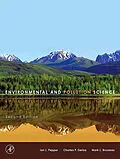Environmental and Pollution Science, Second Edition, provides the latest information on the environmental influence of a significant number of subjects, and discusses their impact on a new generation of students. This updated edition of Pollution Science has been renamed to reflect a wider view of the environmental consequences we pay as a price for a modern economy. The authors have compiled the latest information to help students assess environmental quality using a framework of principles that can be applied to any environmental problem. The book covers key topics such as the fate and transport of contaminants, monitoring and remediation of pollution, sources and characteristics of pollution, and risk assessment and management. It contains more than 400 color photographs and diagrams, numerous questions and problems, case studies, and highlighted keywords. This book is ideally suited for professionals and students studying the environment, especially as it relates to pollution as well as government workers and conservationists/ecologists. - Emphasizes conceptual understanding of environmental impact, integrating the disciplines of biology, chemistry, and mathematics - Topics cover the fate and transport of contaminants; monitoring and remediation of pollution; sources and characteristics of pollution; and risk assessment and management - Includes color photos and diagrams, chapter questions and problems, and highlighted key words
Autorentext
Dr. Ian Pepper is currently a Professor at the University of Arizona. He is also Director of the University of Arizona, Environmental Research Laboratory (ERL) and the NSF Water and Environmental Technology (WET) Center. Dr. Pepper is an environmental microbiologist specializing in the molecular ecology of the environment. His research has focused on the fate and transport of pathogens in air, water, soils and wastes. His expertise has been recognized by membership on six National Academy of Science Committees and former memberships on an EPA FIFRA Science and Advisory Panel. Dr. Pepper is a Fellow of the American Association for the Advancement of Science, American Academy of Microbiology, the Soil Science Society of America, and the American Society of Agronomy. He is also a Board Certified Environmental Scientist within the American Academy of Environmental Engineers and Scientists. He is the author or co-author of six textbooks; 40 book chapters; and over 180 peer-review journal articles.
Klappentext
Environmental and Pollution Science, Second Edition, provides the latest information on the environmental influence of a significant number of subjects, and discusses their impact on a new generation of students.
This updated edition of Pollution Science has been renamed to reflect a wider view of the environmental consequences we pay as a price for a modern economy. The authors have compiled the latest information to help students assess environmental quality using a framework of principles that can be applied to any environmental problem.
The book covers key topics such as the fate and transport of contaminants, monitoring and remediation of pollution, sources and characteristics of pollution, and risk assessment and management. It contains more than 400 color photographs and diagrams, numerous questions and problems, case studies, and highlighted keywords.
This book is ideally suited for professionals and students studying the environment, especially as it relates to pollution as well as government workers and conservationists/ecologists.
- Emphasizes conceptual understanding of environmental impact, integrating the disciplines of biology, chemistry, and mathematics
- Topics cover the fate and transport of contaminants; monitoring and remediation of pollution; sources and characteristics of pollution; and risk assessment and management
- Includes color photos and diagrams, chapter questions and problems, and highlighted key words
Inhalt
Part 1 Processes Affecting Fate and Transport of Contaminants
Chapter 1 The Extent of Global Pollution
1.1 Science and Pollution
1.2 Global Perspective of the Environment
1.3 Pollution and Population Pressures
1.4 Overview of Environmental Characterization
1.5 Advances in Analytical Detection Technology
1.6 The Risk Based Approach to Pollution Science
1.7 Waste Management, Site Remediation, and Ecosystem Restoration
References and Additional Reading
Chapter 2 Physical-Chemical Characteristics of Soils and the Subsurface
2.1 Soil and Subsurface Environments
2.2 Solid Phase
2.3 Gaseous Phase
2.4 Liquid Phase
2.5 Basic Physical Properties
Questions and Problems
References and Additional Reading
Chapter 3 Physical-Chemical Characteristics of Waters
3.1 The Watery Planet
3.2 Unique Properties of Water
3.3 Mechanical Properties
3.4 The Universal Solvent
3.5 Oxidation-Reduction Reactions
3.6 Light in Aquatic Environments
3.7 Oceans
3.8 Lakes and Reservoirs-The Lentic System
3.9 Streams and Rivers-The Lotic System
3.10 Groundwater-Water in the Subsurface
3.11 A Watershed Approach
Questions and Problems
References and Additional Reading
Chapter 4 Physical-Chemical Characteristics of the Atmosphere
4.1 Chemical Composition
4.2 Physical Properties and Structure
Questions and Problems
References and Additional Reading
Chapter 5 Biotic Characteristics of the Environment
5.1 Major Groups of Organisms
5.2 Microorganisms in Surface Soils
5.3 Microorganisms in the Subsurface
5.4 Biological Generation of Energy
5.5 Soil as an Environment for Microbes
5.6 Activity and Physiological State of Microbes in Soil
5.7 Enumeration of Soil Bacteria via Dilution and Plating
5.8 Microorganisms in Air
5.9 Microorganisms in Surface Water
References and Additional Reading
Chapter 6 Physical Processes Affecting Contaminant Transport and Fate
6.1 Contaminant Transport and Fate in the Environment
6.2 Contaminant Properties
6.3 Advection
6.4 Dispersion
6.5 Mass Transfer
6.6 Transformation Reactions
6.7 Characterizing Spatial and Temporal Distributions of Contaminants
6.8 Estimating Phase Distributions of Contaminants
6.9 Quantifying Contaminant Transport and Fate
Questions and Problems
References and Additional Reading
Chapter 7 Chemical Processes Affecting Contaminant Transport and Fate
7.1 Introduction
7.2 Basic Properties of Inorganic Contaminants
7.3 Basic Properties of Organic Contaminants
7.4 Sorption Processes
7.5 Abiotic Transformation Reactions
Questions and Problems
References and Additional Reading
Chapter 8 Biological Processes Affecting Contaminant Transport and Fate
8.1 Biological Effects on Pollutants
8.2 The Overall Process of Biodegradation
8.3 Microbial Activity and Biodegradation
8.4 Biodegradation Pathways
8.5 Transformation of Metal Pollutants
Questions and Problems
References and Additional Reading
Part 2 Monitoring, Assessment, and Regulation of Environmental Pollution
Chapter 9 Physical Contaminants
9.1 Particle Origins
9.2 Particle Size
9.3 Particles in Air or Aerosols
9.4 Particulates in Water
9.5 Summary
Questions and Problems
References and Additional Reading
Chapter 10 Chemical Contaminants
10.1 Introduction
10.2 Types of Contaminants
10.3 Sources:…
